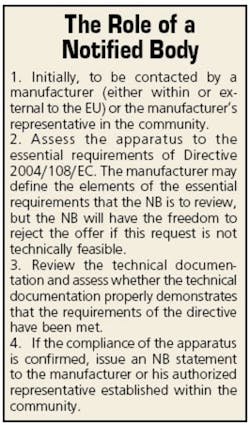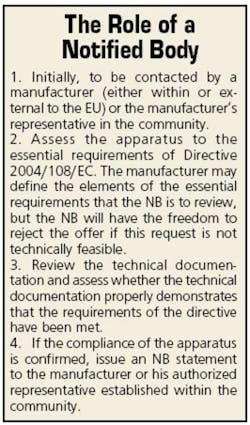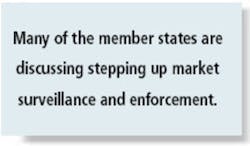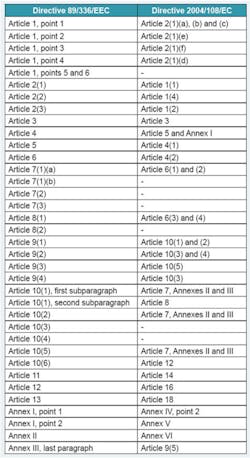With adoption of the new EMC Directive less than two years away, find out how the changes will affect your products entering European markets.
The European Parliament and the Council of the European Union have adopted EMC Directive 2004/108/EC. As of July 20, 2007, EMC Directive 89/336/EEC will be repealed, and any reference thereto will be construed as meaning the new directive. There is a transitional period until July 20, 2009, at which time appara-tus compliant to 89/336/EEC no longer can be placed on the market.
The original EMC Directive was subjected to review by the Simpler Legislation for the Internal Market (SLIM) committee. Both the SLIM committee and others revealed the need to complete, reinforce, and clarify the framework of 89/336/EEC. There are no changes in the concepts of allowing for free movement of goods, persons, services, and capital within the community.
Definitions
Some definitions have been clarified; following are the main ones:
� Equipment means any apparatus or fixed installation.
� Apparatus means any finished appliance or combination made commercially available as a single functional unit, intended for the end user, and liable to generate electromagnetic disturbance or the performance of which is liable to be affected by such disturbance.
� Fixed installation means a particular combination of several types of apparatus and, where applicable, other devices, which are assembled, installed, and intended to be used permanently at a predefined location.
Exemptions
Essentially, the EMC Directive still covers all equipment except the following:
� Equipment covered by 1999/5/EC, the Radio and Telecommunications Terminal Equipment Directive (R&TTE).
� Aeronautical products referred to in Regulation No. 1592/2002.
� Radio equipment used by radio amateurs within the regulation of the International Telecommunication Union (ITU) unless that equipment is commercially available.
The new directive also does not apply to equipment inherently incapable of generating or contributing to the electromagnetic emissions environment that would affect the proper operation of radio and telecommunications equipment. Equipment that will operate without degradation of normal operation within its intended use also is exempt.
Appropriate Measures
Member states still must take appropriate measures to ensure the equipment placed on the market or put into service complies with the requirements of the directive when properly installed, maintained, and used for its intended purpose. The directive does not deal with the safety of equipment because that is covered by other directives.
Harmonized Standards
Article 6, Harmonized Standards, makes a very interesting statement: �Compliance with a harmonized standard is not compulsory.� However, it goes on to say that compliance with harmonized standards whose reference has been published in the Official Journal of the European Union (OJ) shall raise a presumption of conformity with the essential requirements to which the standard relates. If you test to the relevant standards for your product, you can feel fairly assured that your product meets the essential requirements of the directive.
Conformity Assessment
The directive states that conformity assessment should be the responsibility of the manufacturer, without any need to involve an independent conformity assessment body. However, manufacturers should be free to use the services of such a body.
1. If you do not test to harmonized standards, you still need to produce a technical construction file (TCF) demonstrating the measures taken to show compliance to the essential requirements of the directive.
2. The manufacturer no longer is required to have the TCF assessed and approved by a Competent Body (CB) or Notified Body (NB).
This is a good time to address the fact that there no longer will be CBs. The directive now lists only NBs. There is no reason to assume that the current CBs will not become notified because the requirements have not changed to any great degree.
Getting back to the important issue of conformity assessment, the liability of the Declaration of Conformity always is the manufacturer�s responsibility even if the services of an NB are used. Then why would you want to use an NB? Here are a few reasons:
� Reasonable assurance that you did the right thing.
� No in-house EMC expertise.
� Product category selection.
� Production of a thorough TCF (now referred to as Technical Documentation).
� Assurance that relevant standards are applied to show compliance to the essential requirements of the directive.
Notified Bodies
David Imeson, chairman of the European Commission Association of Competent Bodies (ECACB), stated: �Detailed information on the operation of Notified Bodies can be found in Chapter 6 of the Blue Guide.
�In most directives, Notified Bodies play a specific mandatory role in the conformity process, e.g., as an independent test house or certification body carrying out the conformity assessment procedures specified in those Directives. The EMC Directive is different in the sense that the involvement of the NB in the process is totally voluntary and the service required of the NB is to assist the manufacturer or his authorized representative within the Community in the conformity assessment process for his apparatus. The Directive actually applies module A (Internal control of production), see modules in the Blue Guide, which does not require the mandatory involvement of an NB.
�The role of the NB is derived from Article 7 and Annex III, their appointment is defined in Article 12. From this it is clear that their operation applies to but is not limited to apparatus.�
Article 13 states, �However, the provisions of Articles 5, 7, 8 and 9 shall not be compulsory in the case of apparatus which is intended for incorporation into a given fixed installation and is otherwise not commercially available.� This clearly means that manufacturers of fixed installations are not required to use the services of a Notified Body but they may well, in practice, involve them in the process.
Fixed Installations
Another important change in the directive is how fixed installations are handled. The individual pieces of apparatus need not be assessed, tested, or marked in conformance with the directive as apparatus being placed upon the market would have to be. However, the completed fixed installation shall meet the essential requirements of the directive.
� Installations of various apparatus and other devices carrying the CE Marking must be installed and constructed applying good engineering practices.
� Apparatus designed and built or supplied for a specific fixed installation and not otherwise placed in the commercial market for end users are not required to be assessed to the normal conformity assessment procedures. In other words, they do not necessarily need the CE Marking.
� Fixed installations must meet the protection requirements of the directive. Harmonized standards may be used for fixed installations to demonstrate a presumption of conformity.
� The fixed installations section is arguably the area with the most widespread changes and ramifications. Read Article 13 and other pertinent sections carefully.
As with the original EMC directive, a Guidance Document is being prepared and should be available soon.
Correlation Table
Table 1, taken from the new directive, is a good source to determine the upcoming changes.
Conclusion
Don�t wait until the last minute to deal with the changes mandated by the new directive. I fear, just as it happened in 1996 with 89/336, many manufacturers will be scrambling to deal with the changes on July 19, 2009. Now is the time to become familiar with the new directive and its implications for your manufacturing process and products. Major changes are likely in much of your documentation, such as ISO 9000.
Generally, the intent of the EMC directive has not changed. The essential and protection requirements are practically the same with a little different wording. The scope is better defined, and there are new definitions. CBs have been eliminated, and the directive specifies the requirements for NBs.
The elimination of mandatory third-party assessment of TCFs will affect many manufacturers such as:
� Those who produce many different models.
� Apparatus that did not have harmonized standards.
� Large installations that could not be tested to the harmonized standards.
� Apparatus for which no harmonized standards existed.
Having attended many sessions about the new directive, I can inform you that many of the member states are discussing stepping up market surveillance and enforcement. Be ready!
About the Author
Gary Fenical is the EMC technical support engineer at Laird Technologies and has been with the firm for 21 years. He has more than 37 years electronic experience in the operation and maintenance of RF and digital systems for military and commercial applications and secure telecommunications and computer network systems. Mr. Fenical also is a special government employee for the FDA as an EMC consultant, chairman of the SAE AE-4 Committee on Aerospace EMC, and a member of the USCEL Executive Committee, IEEE EMC Society, SMRI. Laird Technologies, P.O. Box 650, Shielding Way, Delaware Water Gap, PA 18327, 570-424-8510, e-mail: [email protected]
FOR MORE INFORMATION
on EMC Directive 2004/108/EC
www.rsleads.com/602ee-176
on the Blue Guide
www.rsleads.com/602ee-177
February 2006



